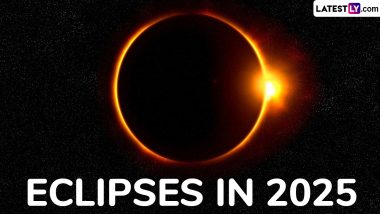New Delhi, October 6: October, known for its autumnal charm, is also set to offer a breathtaking spectacle from the cosmos - a double celestial treat in the form of a Solar and Lunar Eclipse this year. These celestial events, steeped in history and mystique, have always held humanity in their inspiring myths, legends, and a sense of awe. All stargazers and astronomy enthusiasts will be thrilled by these two exciting astronomical events in October 2023. These celestial phenomena continue to capture the imagination and wonder of people around the world.
As October unfolds, let's dive into the details of these cosmic events and the best ways to witness them. On October 14, 2023, an annular Solar Eclipse will grace the skies. This phenomenon occurs when the Moon, appearing smaller than the Sun due to its distance from Earth, creates a mesmerising image that appears to be a "ring of fire" as it passes in front of the Sun. This breathtaking event will last for a few minutes, with the Sun momentarily transformed into a radiant halo around the Moon. Solar Eclipse, Lunar Eclipse in October 2023: Surya and Chandra Grahan Set to Grace Skies This Month; Check Dates, Timings, When and Where to Watch the Celestial Showdown In India.
Different Types Of Solar Eclipses
- Total Solar Eclipse: When the Moon passes between the Sun and Earth, completely blocking the face of the Sun, a Total Solar Eclipse takes place.
- Annular Solar Eclipse: When the Moon covers the Sun's center, leaving the Sun's visible outer edges to form a “ring of fire” or annulus around the Moon, an annular solar eclipse occurs.
- Partial Solar Eclipse: When the Moon passes between the Sun and Earth but the Sun, Moon, and Earth are not perfectly lined up, a Partial Solar Eclipse occurs.
- Hybrid Solar Eclipse: An eclipse can shift between annular and total, thanks to the Earth's curved surface, and the Moon’s shadow moves across the globe, resulting in a Hybrid Solar Eclipse. Will Surya Grahan 2023 Be Visible in India? Solar Eclipse Date and Time – All You Need To Know About the First Solar Eclipse of the Year.
How To View Solar Eclipse From India - Livestreaming Details
Multiple reports suggest that the annular Solar Eclipse won't be visible from India. However, sky enthusiasts need not fret. NASA will live-stream the event on its YouTube channel, ensuring viewers worldwide can witness this cosmic marvel. According to the Space.com report, the livestream will start on October 14 at 11.30 am EDT (around 9 pm IST) and end at 1.15 pm EDT (around 10.45 pm IST).
Precautions To Take
Make sure your eclipse glasses or handheld viewer is in shape. As NASA says, "Do NOT look at the Sun through a camera lens, telescope, binoculars, or any other optical device while wearing eclipse glasses or using a handheld solar viewer — the concentrated solar rays will burn through the filter and cause serious eye injury."
(The above story first appeared on LatestLY on Oct 06, 2023 11:13 AM IST. For more news and updates on politics, world, sports, entertainment and lifestyle, log on to our website latestly.com).













 Quickly
Quickly




















